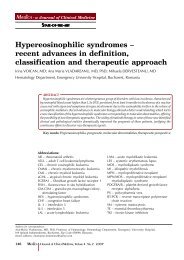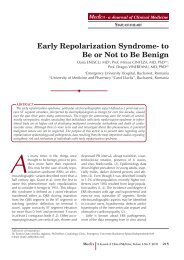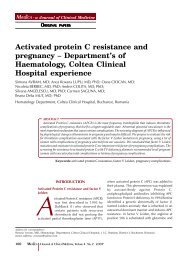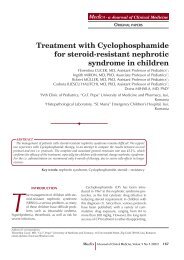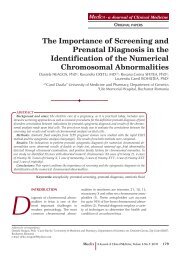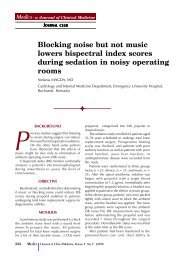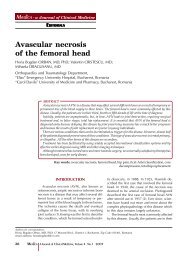Diagnostic Hysteroscopy - A Retrospective Study of 1545 Cases
Diagnostic Hysteroscopy - A Retrospective Study of 1545 Cases
Diagnostic Hysteroscopy - A Retrospective Study of 1545 Cases
Create successful ePaper yourself
Turn your PDF publications into a flip-book with our unique Google optimized e-Paper software.
VITAMIN D RECEPTOR FOKI (C/T) AND BSMI (A/G) & POLYCYSTIC OVARY SYNDROME<br />
INTRODUCTION<br />
<strong>Hysteroscopy</strong> is performed for<br />
eva luation or treatment <strong>of</strong> different<br />
pathologies <strong>of</strong> the endometrial<br />
cavity, tubal ostia, or endocervical<br />
canal for diagnostic<br />
alo ne or for diagnostic and treatment in the<br />
same operative time (1,2).<br />
A review published on Up To Date in 2011<br />
synthesizes the indications <strong>of</strong> diagnostic and<br />
operative hysteroscopy as follows: abnormal<br />
pre menopausal or postmenopausal uterine ble -<br />
e ding, endometrial polyps, sub-mucosal, and<br />
some intramural, fibroids, intrauterine ad hesions,<br />
Müllerian anomalies (eg, uterine septum),<br />
retained intrauterine devices (retained<br />
IUD ) or other foreign bodies, retained products<br />
<strong>of</strong> conception, desire for sterilization, endocervical<br />
polips (3).<br />
Contraindications to hysteroscopy are: viable<br />
intrauterine pregnancy, active pelvic infection<br />
(including genital herpes infection) (4),<br />
kno wn cervical or uterine cancer.<br />
The possibility to perform hysteroscopy<br />
u sing no anesthetic or local anesthesia allows<br />
use <strong>of</strong> outpatient settings and speeds recovery.<br />
The vaginoscopic, or “no touch,” technique is<br />
performed without a speculum or tenaculum<br />
and without anesthesia (5). Bettocchi introduced<br />
the ‘no-touch’ trans-vaginal approach,<br />
where no instruments expose or grasp the cervix<br />
(6,7). Most diagnostic and brief or minor<br />
operative pro cedures can be performed without<br />
anesthe tic or with a local anesthetic. Regional<br />
or gene ral anesthesia is reserved for patients<br />
who cannot tolerate a procedure under<br />
local anesthesia, extensive operative procedures,<br />
or patients with comorbidities that necessitate<br />
intensive monitoring (7).<br />
FIGURE 1. The type <strong>of</strong> anesthesia used for hysteroscopy.<br />
One factor in deciding whether to use a<br />
para-cervical block versus no anesthetic is the<br />
pain <strong>of</strong> the injection; some women find the injection<br />
<strong>of</strong> the anesthetic agent more painful<br />
than the procedure itself (8,9). Some surgeons<br />
advocate using no anesthetic (10,11). In our<br />
study, about 20% <strong>of</strong> the diagnostic hysteroscopies<br />
were performed using the „no-touch”<br />
technique with very good tolerance. This technique<br />
is used by a couple <strong>of</strong> surgeons who<br />
were trained by pr<strong>of</strong>essor Bettocchi at “Pr<strong>of</strong>.<br />
Dr. Panait Sirbu” Obstetrics and Gynecology<br />
Hospital in 2005. <br />
MATERIAL AND METHOD<br />
This paper is a retrospective study <strong>of</strong> <strong>1545</strong><br />
diagnostic hysteroscopies performed in the<br />
“Pr<strong>of</strong>. Dr. Panait Sirbu” Obstetrics and Gynecology<br />
Hospital between January 1, 2008 and<br />
June 30, 2011. Total number <strong>of</strong> hysteroscopies<br />
performed in this period was 3220. Those patients<br />
who underwent hysteroscopy for patholo<br />
gy suspected via another imagistic method<br />
were initially investigated using trans-vaginal ultrasonography<br />
or hysterosapingography (HSG).<br />
Before hysteroscopy, the standard investigations<br />
were represented by: PAP smear, vaginal<br />
bacteriologic tests, hemograms.<br />
Antibiotics are not routinely administered<br />
during hysteroscopy for prevention <strong>of</strong> surgical<br />
site infection or endocarditis since post<br />
hysteros copy infection occurs in less than 1<br />
percent <strong>of</strong> women (12).<br />
The following parameters were studied: diagnostic<br />
hysteroscopy indications, type <strong>of</strong> anesthesia<br />
used, correlation between pre-and po stoperative<br />
diagnoses. <br />
OUTCOMES<br />
During the period 1 st January 2008 till 30<br />
June 2011, in the „Pr<strong>of</strong>.dr.Panait Sîrbu”<br />
Clinical Hospital <strong>of</strong> Obstetrics Gynecology, in<br />
Bucharest, there was a total number <strong>of</strong> 3220<br />
hysteroscopies. The distribution <strong>of</strong> pathologies<br />
is expressed in Table 1. Of these 3220 hysteroscopies,<br />
a number <strong>of</strong> <strong>1545</strong> were diagnostic hysteroscopies.<br />
Anesthesia. The type <strong>of</strong> anesthesia used for<br />
the 3220 hysteroscopy shows the prevalence <strong>of</strong><br />
interventions performed without any type <strong>of</strong><br />
anesthesia (61%). General anesthesia with orotracheal<br />
intubation was used mainly for com-<br />
310 Maedica A Journal <strong>of</strong> Clinical Medicine, Volume 7 No.4 2012




